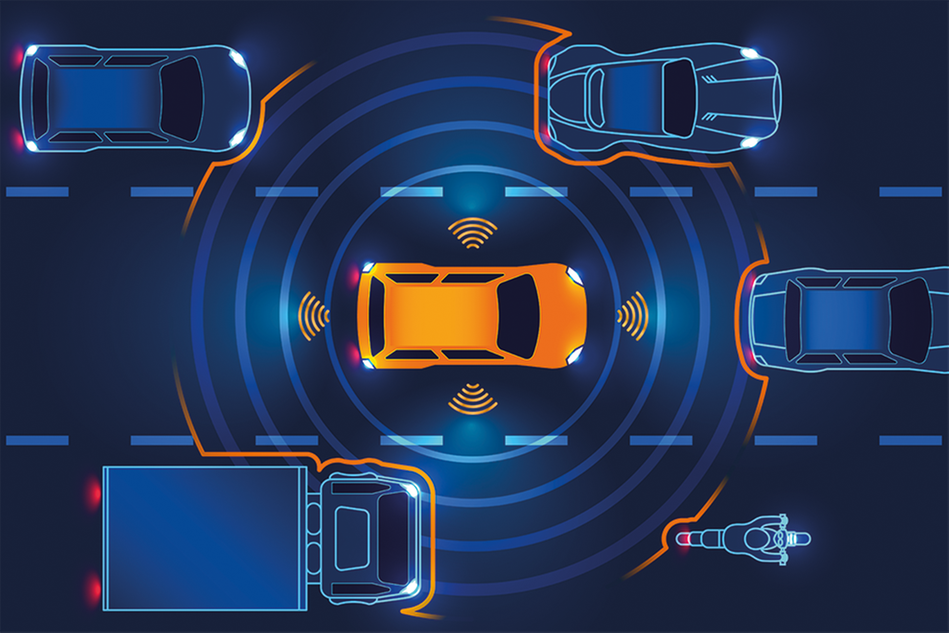Multi antenna systems improve indoor positioning and autonomous vehicles
Marco Marinho, a PhD student at Halmstad University, has made the practical implementation of multi antenna systems possible. These systems have until now been mostly limited to theory and very hard to apply in practical scenarios. The applied implementation makes it possible to extend the lifetime of sensor networks and to detect the location of radio transmissions of other users in a wireless network with very high accuracy. This can for example be used in precise indoor positioning and by autonomous vehicles. On March 5, Marco Marinho will present and defend his doctoral thesis on the subject.
”One very useful application is in our future smart vehicles. The technology with these multiple antenna systems can detect either another vehicle or a pedestrian before the driver can see them and avoid what could be a possible fatal accident”, says Marco Marinho.
Multiple antenna systems – so called MIMO (multiple-input multiple-output) – multiplies the capacity of a radio link using several transmit and receive antennas. MIMO has become an essential part of wireless communication standards.

”Multiple antenna systems have made their way into our daily lives, even if we do not see them. For instance, when a WiFi router has more than one antenna. Cellphone towers are normally also equipped with such systems nowadays”, says Marco Marinho.
Positioning with one centimeter accuracy
”The main use of multiple antenna systems today is to get faster data rates with wireless communication. However, when these antennas are organised in a certain way, they can be used for various other applications, one of them being efficient communication between vehicles and another being indoor positioning.”
”Precise positioning in indoor locations is still a great challenge, but I believe the method presented in the thesis could be of great use in such scenarios.”
For example, indoor positioning may be useful for finding your way at major airports or in large shopping centers. Digital guides at a museum can tell which artwork the visitor stands in front of based on his or her position. Precise positioning can also be used to locate goods in a warehouse.
One surprising result from the research has been the extreme precision of positioning:
–”The precision at which we were able to track users using such multi antenna systems was very surprising to me. Under the right conditions, we could pinpoint the position of a user with an accuracy of around one centimeter”, says Marco Marinho.
”Love at first sight”
Marco Marinho graduated as a Network Engineer in University of Brasília in Brazil.
”During my bachelor studies, I came across the topic of array processing (signal processing for multi antenna systems) and it was love at first sight. I began doing some research then and had the opportunity to stay at DLR (the German Aerospace Center) during my master studies, where I got to know a lot about GPS and positioning systems in general.”
During the PhD studies that followed, Marco Marinho was introduced to Professor Alexey Vinel at Halmstad University.
”After a few talks with Professor Vinel it became clear that my know-how on array processing and positioning could be useful in the context of vehicular networks, which is a research topic of interest at Halmstad University. I was told by the first PhD student at Halmstad University, Edison Pignaton, that the environment and conditions in Halmstad University were great, so I took the opportunity to come do my research here.”
Practical use of antenna systems
Marco Marinho works with Professor Alexey Vinel, and the two of them cooperate with Professor Fredrik Tufvesson at Lund University. The research goal the past four years has been to find ways to improve energy efficiency and interaction between mobile and static nodes in wireless sensor networks using cooperative MIMO techniques. Marco Marinho has also studied the practical use of these multi antenna systems in the communication between heavy duty vehicles in a platoon*.
”For the first three years of my PhD, my research was almost purely basic research, mathematical models and formulations. During this past and final year, we have developed the practical aspects of our research.”
The young researcher would like to continue his exploration within the area:
”My goal is a postdoctoral position where I can keep researching these topics.”
Text: Louise Wandel
*Platoon: linking of two or more vehicles in convoy, using connectivity technology and automated driving support systems.
Read more
Doctoral defense on March 5
Time: 10:15 in Halda, Visionen (J Building), Halmstad University
Title of thesis: Array Processing Techniques for Direction of Arrival Estimation, Communications, and Localization in Vehicular and Wireless Sensor Networks
Supervisor: Alexey Vinel, Halmstad University.
Co-supervisors: João Paulo Carvalho Lustosa da Costa, University of Brasília and Felix Antreich, Federal University of Ceará
Opponent: Henk Wymeersch, Chalmers University of Technology
Examining Committee: Pierluigi Salvo Rossi, Norwegian University of Science and Technology and Tingting Zhang, Mid Sweden University and Sébastien Roland Marie Joseph Rondineau, University of Brasília

